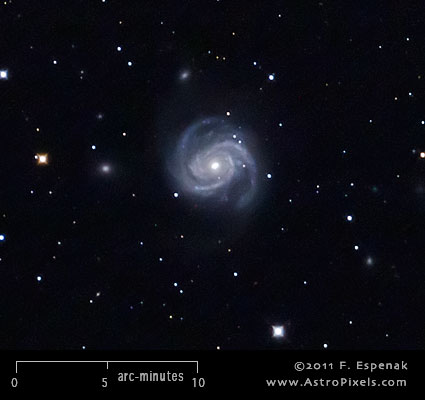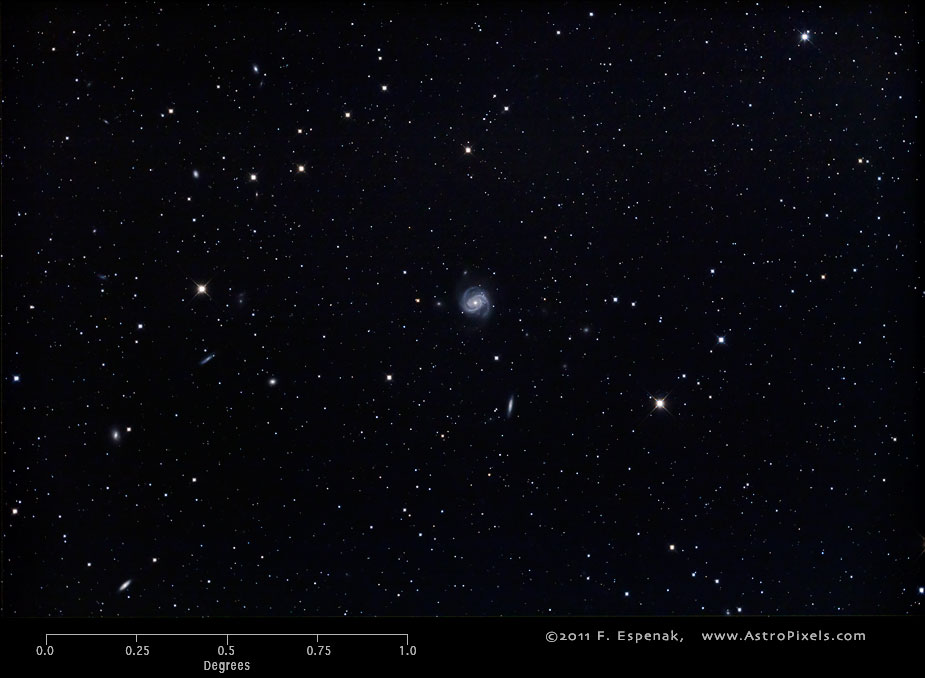
M100
Messier 100 or M100 (also designated NGC 4321) is a spiral galaxy in the constellation Coma Berenices. It has an apparent visual magnitude of 9.3 and its angular diameter is 7x6 arc-minutes. M100 lies at an estimated distance of 60 million light years. The Equinox 2000 coordinates are RA= 12h 23m, Dec= +15° 50´ which makes M100 best seen during the spring. The Messier Spring Star Chart shows the position of all Messier objects visible during that season.
The image above shows the uncropped view of M100 through the Takahashi E-180 Astrograph (North is up). A 3x enlargement of this image appears to the right.
This spiral galaxy was discovered by P. Méchain in 1781. It is one of the brightest and most beautiful spiral galaxies in the Virgo Cluster of galaxies. The 3rd Earl of Rosse included it in his list of 14 "spiral nebulae" in 1850.
According to Stoyan et al. (2010), the distance of M100 is 49.6 million light years and its diameter is 107,000 light years. Its estimated mass is 200 billion solar masses.
For more information, see the Messier Catalog as well as specific entries for M100 in Wikipedia and SEDS.
Messier's Description of M100
April 13, 1781
`Nebula without star, of the same light as the preceding
[M99], situated in the ear of Virgo. Seen by M.
Méchain on March 15, 1781. These three nebulae, nos. 98, 99 and
100, are very difficult to recognize, because of the faintness of their
light: one can observe them only in good weather, and near their passage
of the Meridian.'
Technical Details
- Object: M100
- Other Names: NGC 4321
- Object Type: spiral galaxy
- Object Data: Apparent Magnitude = 9.3, Angular Size = 7x6 arc-minutes
- Object Position (Equinox 2000): RA= 12h 23m, Dec= +15° 50´, Constellation = Coma Berenices
- Date/Time: 2011 Apr 05 at 04:57 UTC
- Location: Bifrost Astronomical Observatory, Portal, AZ
- Mount: Astro-Physics 1200GTO
- Telescope: Takahashi Epsilon 180 Hyperbolic Astrograph
- Camera: Canon EOS 550D (Rebel T2i) (modified with a Baader UV/IR filter)
- Field of View: 1.70° x 2.56° at 1.7 arc-sec/pixel (web version: 10.0 arc-sec/pixel)
- Exposure: 4 x 300s, f/2.8, ISO 800
- File Name: M100-01w.jpg
- Processing (Adobe Camera Raw): Graduated Filter, Vignetting Correction, Noise Reduction, White Balance, Curves
- Processing (Photoshop CS5): Average Images, Curves, Noise Reduction
- Original Image Size: 3454 × 5179 pixels (17.9 MP); 11.5" x 17.3" @ 300 dpi
- Rights: Copyright 2011 by Fred Espenak. All Rights Reserved. See: Image Licensing.
